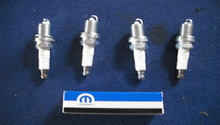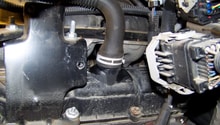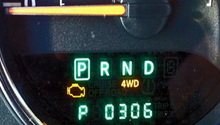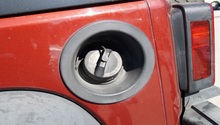Jeep Wrangler JK: Why is My Engine Misfiring?
A consistent misfire will hamper engine performance and cause drivability issues. The cause of a misfire is often from a loss of spark (ignition system), improper air-fuel mixture/lack of fuel (fuel system), or a loss of compression (mechanical). On paper, a misfire may seem easy to diagnose, but there are number of components that need to be inspected before throwing parts at the vehicle.
This article applies to the JK Jeep Wrangler (2007-Present).
An engine misfire is a common problem that can greatly affect the drivability of your Jeep. Simply put, an engine misfire is a condition where the air-fuel mixture in a given cylinder fails to ignite at the correct time, or in some cases, does not ignite at all. The result of a misfire can typically be felt as a slight shaking or vibration accompanied by a loss of engine power. In some cases, misfires may cause hard starting issues or occasional engine stalling. While an engine can continue to operate with a misfire, fuel economy, performance, and tailpipe emissions will suffer. In severe cases, engine damage can occur. This article will outline several common problems that can result in an engine misfire on the JK Jeep Wrangler and the steps that should be taken to solve the issue.

Materials Needed
- Scan tool or code reader
- Digital multimeter
- Metric wrench and socket set
- 5/8" spark plug socket
- 1/4" and 3/8" drive ratchets and extensions
- HEI spark tester
Step 1 – Scan for diagnostic fault codes
When experiencing an engine misfire, the first step is to scan the computer for diagnostic fault codes. By hooking up an OBD-II code reader or scan tool to the diagnostic port located under the driver's side dash, fault codes can be retrieved from the PCM. While the displayed fault codes will not typically show the specific reason for a engine misfire, it will narrow down which cylinder(s) is experiencing a misfire issue and can help pinpoint your efforts in diagnosing the problem.

Step 2 – Inspect air filter
While it the may seem simple and mundane, inspecting the cleanliness of the air filter element and airbox assembly can shed light on a misfire issue. For proper combustion to occur, manufacturers typically aim for a 14.7:1 air-fuel ratio. With many JK Wranglers seeing some degree of off-road duty, the air filter can become overly dirty and upset the air-fuel mixture, leading to misfires. Whether you are using the stock paper filter or an aftermarket reusable element, replacing or cleaning the filter is a quick and inexpensive job that may cure your misfire issue.
(Related Article: How to Replace Air Filter - JK-Forum.com)

Step 3 – Check spark plug wires/coils
The spark plug wires (2007-2011 models) or coils-on-plug boots and wiring (2012+) can be quickly as well as easily inspected to ensure they are not the source of your misfire issue. Early JK models use traditional spark plug wires to transfer the electrical current produced by the coil pack to each spark plug. Inspect the plug wires to ensure they are in place and securely fastened to the spark plugs and coil pack towers. Plug wires have the tendency to age and can limit or prevent the necessary high voltage needed to arc at the spark plug and ignite the air-fuel mixture. Inspect the condition of the plug wires. If they are cracked, split or burnt, replace them as necessary. The internal resistance of each plug wire can also be checked with a digital multimeter. It is also worthwhile to inspect the ignition coil. By removing the fuel pump fuse located in the TIPM, a spark plug or HEI spark tester can be attached to each individual plug wire and the engine cranked over. A lack of spark will indicate a problem with the coil or coil circuit.

2012+ JKs equipped with the Pentastar V6 engine use a coil-on-plug for each spark plug and eliminates traditional plug wires as well as coil packs. However, the individual coils can suffer problems as well. Inspect the coil boots for splits or crack. Similarly, inspect the coil body because they can crack from heat as well as age and should be replaced if their conditions are suspect. Inspect the coil electrical plugs for any signs of burnt pins or melted/chaffed wiring. Ensure the electrical harness for each coil is securely plugged in.
Step 4 – Inspect spark plugs
Spark plugs go hand-in-hand with spark plug wires and coils, and, in many cases, are the culprits behind a misfire issue. Spark plugs are maintenance items that have a finite service life. In some cases they can fail prematurely and prevent the air-fuel mixture from igniting in their respective cylinders. Removing the spark plug from the cylinder(s) suffering from a misfire and giving it a thorough visual inspection can quickly give insight into its condition. Inspect the ceramic insulator for any signs of damage. Check the electrode, electrode strap, and inner insulator for any abnormal wear. Also, be sure to examine the burn color and inspect for any signs of contamination (excessive fuel, oil, carbon, etc).
(Related Article - How to Replace Spark Plugs - JK-Forum.com)

Step 5 – Check crankshaft position sensor
The crankshaft position sensor (CKP) monitors the crankshaft position and rotational speed. This information is sent to the PCM where the necessary ignition timing and fueling is determined for proper combustion. While a failed crankshaft sensor will prevent the engine from running, a faulty or failing sensor can cause intermittent misfires and general rough running conditions. As with spark plug wires and coils, ensure the CKP wiring harness is firmly connected and is in good condition without any burns, chaffs, or frays. The CKP itself is a sealed unit that cannot be worked on, and instead needs to be replaced as a whole. Fortunately, they are relatively inexpensive and easy to replace.

Step 6 – Check fuel system
Whenever multiple cylinders are experiencing misfires, a fueling issue may be the root of the cause. A lack of proper fuel pressure to the injectors often causes the engine to misfire under a load or during heavy acceleration. While low fuel pressure may allow the car to run fine at lower RPMs or while cruising, the need for additional fueling at higher RPMs may not be met and cause a misfire or, in severe case, stalling. The JK uses an in-tank fuel pump that incorporates two extended life non-serviceable fuel filters, so any thoughts of replacing a clogged fuel filter can be thrown out the window. Tapping into the fuel rail with a fuel pressure test kit can quickly identify if the fuel pump is up to the task of supplying enough fuel. Poor fuel pressure can indicate a failing or clogged fuel pump. If the fuel pressure measures within factory specs, a faulty fuel injector may be the problem. Some owners have experienced injector failures on a somewhat consistent basis and, by isolating the bad injector (scanning for cylinder misfire codes), have swapped in a new unit with great results.

Step 7 – Follow factory troubleshooting procedure
In the case that the previously mentioned components did not fix your misfire issue, Chrysler recommends using the following diagnostic procedure.
Note: Component that affect crankshaft speed can cause a misfire.
- Inspect the serpentine belt and engine driven accessories (AC-compressor, water pump, power steering pump) for wear, binding, or pulley misalignment.
- Inspect the PCM for corroded ground and power circuits.
- Check for proper mounting and wiring connections of the crankshaft position sensor (CKP), camshaft position sensor (CPS), manifold absolute pressure sensor (MAP), and throttle body sensor (TB).
- Inspect for restricted intake and exhaust components.
- Inspect for vacuum leaks.
- Inspect PCV system.
- Inspect for internal engine component failure. (Compression test, valve train inspection, etc.)
If none of the components listed above prove faulty, Chrysler advises individually testing the following items:
- ASD RELAY OUTPUT CIRCUIT
- INJECTOR CONTROL CIRCUIT
- COIL CONTROL CIRCUIT
- IGNITION WIRE
- SPARK PLUG
- IGNITION COIL
- FUEL PUMP INLET STRAINER PLUGGED
- RESTRICTED FUEL SUPPLY LINE
- FUEL PUMP MODULE
- FUEL PRESSURE LEAK DOWN
- FUEL INJECTOR
- ENGINE MECHANICAL
- POWERTRAIN CONTROL MODULE (PCM)
Note
Chrysler's 3.6L Pentastar engine as equipped in 2012+ JK Wranglers have had cylinder head issues that result in a loss of compression and subsequent misfires. While it seems to have been a quality control issue, Chrysler is replacing cylinder heads under warranty.
Related Discussions
- Another Misfire Post - JK-Forum.com
- Misfire at Idle but No Engine Codes - JK-Forum.com
- Fuel Filter? - JK-Forum.com






